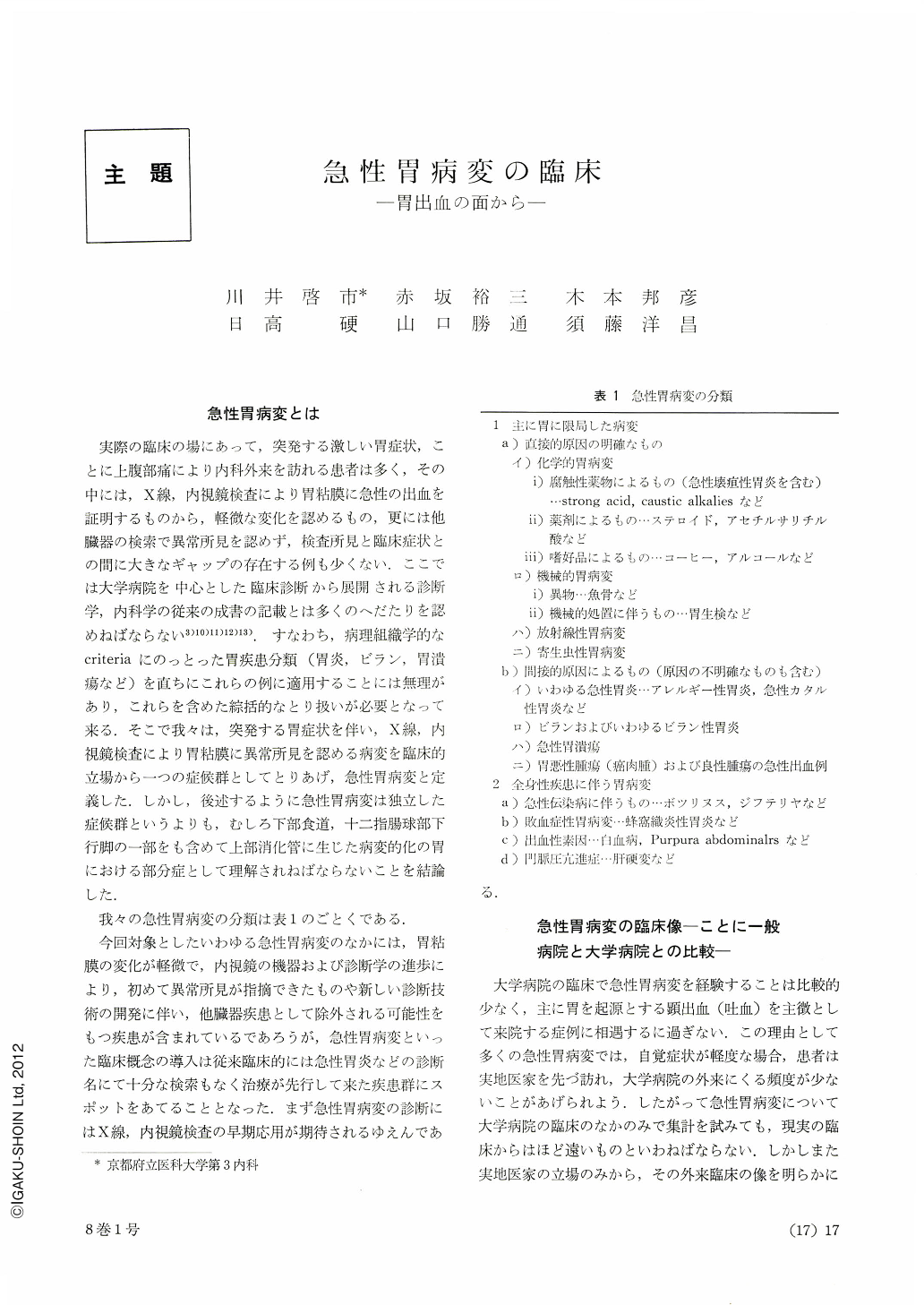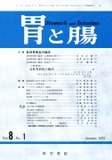Japanese
English
- 有料閲覧
- Abstract 文献概要
- 1ページ目 Look Inside
- サイト内被引用 Cited by
急性胃病変とは
実際の臨床の場にあって,突発する激しい胃症状,ことに上腹部痛により内科外来を訪れる患者は多く,その中には,X線,内視鏡検査により胃粘膜に急性の出血を証明するものから,軽微な変化を認めるもの,更には他臓器の検索で異常所見を認めず,検査所見と臨床症状との間に大きなギャップの存在する例も少くない.ここでは大学病院を中心とした臨床診断から展開される診断学,内科学の従来の成書の記載とは多くのへだたりを認めねばならない3)10)11)12)13).すなわち,病理組織学的なcriteriaにのっとった胃疾患分類(胃炎,ビラン,胃潰瘍など)を直ちにこれらの例に適用することには無理があり,これらを含めた綜括的なとり扱いが必要となって来る.そこで我々は,突発する胃症状を伴い,X線,内視鏡検査により胃粘膜に異常所見を認める病変を臨床的立場から一つの症候群としてとりあげ,急性胃病変と定義した.しかし,後述するように急性胃病変は独立した症候群というよりも,むしろ下部食道,十二指腸球部下行脚の一部をも含めて上部消化管に生じた病変的化の胃における部分症として理解されねばならないことを結論した.
From the clinical standpoint acute gastric lesions are defined as those that harbor both endoscopically and roentgenologically abnormal findings on the gastric mucosa accompanied with acute gastric symptoms. After they have been divided according to their frequency, clinical pictures caused by them have been correlated as well between patients treated in general hospitals and those in affiliated hospitals.
Subjective symptoms most often given by both groups of patients were in the order of their freque-ncy epigastric pain followed by nausea and vomiting. Patients in general hospitals received medical attention earlier than those in affiliated hospitals: about half of the former were treated within there days after the onset of symptoms. In about 70 per cent of patients in both groups a definite diagnosis was arrived at more than five days after the initial consultation with subsequent x-ray and endoscopic examinations. Only minor changes without any apparent causes (so-called gastritis) weer seen in 70 per cent of patients in both groups, followed in the order of frequency by peptic ulcer and specific gastritis due to chemical agents.
Most of subjective symptoms in acute gastric lesions subsided within a day or two, and their clinical manifestations also disappeared mostly within a week. Sometimes x-ray revealed scirrhus-like findings in acute lesions as well, and permanency of pathological pictures was most important for discrimination between benign and malignant lesions. Occasional slight bleeding, edema and decreased distensibility of the gastric wall at times confused the overall picture, but differentiation was not so difficult because these findings were transient. Were stress simply laid on hemorrhage in the upper digestive tract, acute gastric lesions with complaint of gross bleeding should be endoscopied more than three days after the initial hemorrhage. Instruments most suited for this purpose are either GIF type D (Olympus) or Panview endoscope (Machida).
Except for gross gastric bleeding, internal management alone suffices mostly for the treatment of acute gastric lesions. Our three fundamental principles for it are (1) rest, both local and general; (2) causal treatment; and (3) medical manamegent. In view of recent increasing tendency of iatrogenic acute gastric lesions due to medication such as steroids, their prevention is especially emphasized here.

Copyright © 1973, Igaku-Shoin Ltd. All rights reserved.


